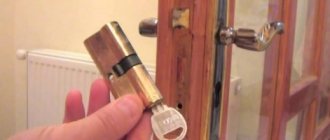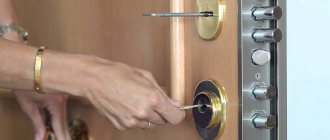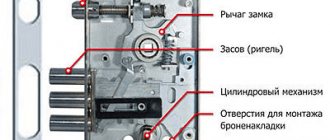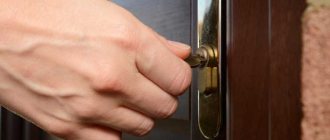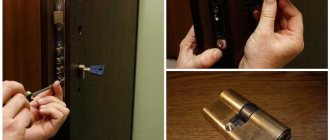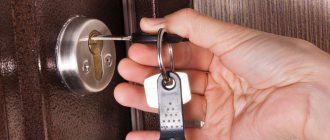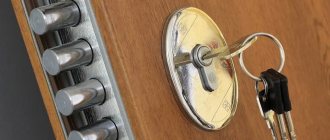The first English cylinders for door locks appeared in the 19th century, but the removable design turned out to be so successful that they are still produced to this day. Next, we will analyze in detail 7 rules for choosing cylinders, plus you will learn how to replace the cylinder in a door lock with your own hands in a few minutes.
You can replace the front door lock cylinder within a few minutes
Design features of lock cylinders
The same models of locks are installed in both wooden and iron doors, but installing a lock in a metal door requires higher professional skills, plus the availability of expensive tools. Therefore, it is easier for people to change the door lock cylinder and leave the locking mechanism the same.
From a design point of view, the front door lock cylinder comes in 3 types - disc, cross and cylinder.
Cylindrical larvae are also called pin, pin and English. Visually, they are not much different, and their operating principle is similar.
- The disc cylinder of the door lock is opened with a semicircular key and itself has a round shape. The reliability of the disk mechanism leaves much to be desired, and replacing the door lock cylinder here takes more time. The only advantage is the affordable price;
A door lock with a disc mechanism is more difficult to replace than a cylindrical model.
- A cylinder with a cross mechanism is equivalent in reliability to a disk mechanism. A cross-shaped key with 4 edges looks impressive, but the structure of the cylinder is extremely simple. To enter without a key, robbers remove the cover, insert a Phillips screwdriver into the hole and turn it with a powerful movement, after which the lock opens;
If the main lock in your home is a mechanism with a cross cylinder, then it is advisable to completely change the lock or install more serious protection nearby.
The Phillips door lock cylinder can be broken using only a powerful Phillips screwdriver
- The cylinder type mechanism is considered the most reliable, plus you can change the cylinder in the lock in a couple of minutes, using only one screwdriver. In addition, English larvae have a number of improved modifications that are quite difficult to drill or knock out.
Since robbers try to drill out the cylinder in every second case, most modern mechanisms are initially equipped with protection against drilling
Due to low reliability, I don’t see any point in dwelling in detail on the disk and cross versions. Although they are sold to this day, they are not very popular, so we will concentrate on choosing a cylinder mechanism, but first we will learn how to change the cylinder with our own hands.
How to replace a lock cylinder with your own hands
- Even before disassembling the cylinder of the old lock, it is advisable to lubricate the mechanism of the new cylinder. For these purposes, a special silicone grease is produced, but if you don’t mind spending money on it, buy regular machine oil;
Before removing the door lock cylinder, it is advisable to lubricate the mechanism; liquid types of machine oil are used for this.
- When disassembling, enter the lock hole with the key, open it and leave the key in the neutral position;
- Now let's disassemble the mount. To do this we need to unscrew the fixing screw. The head of the screw is located on the end plate of the lock, just opposite the cylinder. The screw is completely unscrewed and pulled out;
- When the screw is removed, the cylinder should come out freely;
If, after removing the fixing screw, the cylinder does not come out of the lock, try moving the key while simultaneously trying to pull out the cylinder. The locking cam must be in the zero position and then the mechanism will come out.
Replacing the lock cylinder of the front door with your own hands is not particularly difficult even for a complete amateur
- After removing the old larva, install a new one. If a new cylinder has not yet been purchased, then take the old one, go to the store and ask the seller for the same one, after which you insert it into the lock and tighten the fixing screw;
- Replacing the front door lock cylinder with your own hands is finished, you can use it.
When a cylinder is not a panacea
However, remember that the cylinder itself, no matter how expensive it may be, is only one element in the overall security system of your premises, which includes many components, including:
- door leaf strength;
- hinge reliability;
- presence of armored linings;
- installation of two locks, etc.
Therefore, if you have a lightweight door installed, the leaf of which can be broken with a kick, or the hinges are unreliably protected and therefore easy to cut, then even the most expensive cylinder will not prevent burglars from entering the house.
We are sure that this information will help you decide which lock cylinder to choose !
Seven tips for choosing
Do not attempt to repair the mechanism yourself. For an amateur, repairing a lock cylinder with your own hands is an incredibly difficult task. After assembly, you will have a lot of “extra” parts left, plus the lock itself can be opened by any flat object that looks like a key. Only replacing the cylinder will help here.
High-quality repair of the lock cylinder at home is almost impossible
Tip #1. Deciding on the package
According to the configuration, cylinder cylinders come in 2 types:
- Key plus key - an option where keys are inserted on both sides, the good thing is that if you insert the key from the inside, you can’t open the lock from the outside;
- Key plus a screw - if a screw is installed on the inside instead of a key, then in the event of a fire or some other emergency, it will not be difficult to quickly unlock the lock.
The configuration and type of lock cylinder is determined depending on the specific situation
Tip #2. Selecting the privacy level
Pins are responsible for encoding the larvae; they are also called pins; they are located at the bottom of the mechanism. The pins, by means of springs, fit into the cutouts on the key, each pin corresponds to a given position, thus setting the level of secrecy.
- In budget models, 5 pins are installed and secrecy is limited to ten thousand options;
- In the middle price category, 6 pins are installed and the number of options increases to fifty thousand;
- Expensive locks have 6 or more pins, plus additional secrets, such as magnetic inserts. The number of options here starts from one hundred thousand, but usually manufacturers indicate several million.
The more pins are installed on the lock cylinder, the higher the level of secrecy of the mechanism
Tip #3. Lock cylinder weight
If the larva weighs around 100 grams, then you are dealing with a cheap model, the insides of which are made of aluminum or silumin. It won't last long. A high-quality product with a steel or bronze mechanism cannot weigh less than 180 grams, and the weight of some models reaches 250 grams.
You can determine the quality of the larva by weight; the weight of a normal model starts from 180 g
Tip #4. Drill protection
It is impossible to visually see the protection against drilling of the lock cylinder. The fact is that such protection is provided by the internal insert and pins made of high-strength steel. The only advice that can be given in this case is to carefully study the accompanying documentation and choose a reliable manufacturer.
Protection against drilling is provided by steel inserts in the lock cylinder
There are cylinders with vertical milling into which the key is inserted horizontally. Advertising claims that this is a sign of high security, but in reality their resistance to hacking is no different from traditional larvae with a vertical key arrangement.
Larvae with a horizontal keyhole have the same resistance to burglary as their relatives with a vertical key.
Tip #5. Bump protection
Bumping is the name given to knocking out a keyhole with a heavy tool. The robbers place some kind of superstructure on the keyhole and hit it with a heavy hammer or sledgehammer, after which the larva flies inside the home, and without it you can open the lock with any screwdriver.
Anti-bumping cylinders can be recognized by the presence of a special steel bracket on the side of the mechanism. According to the manufacturers, this bracket can withstand heavy loads and will not allow the lock to be knocked out.
The steel bracket serves to protect against knocking out the cylinder with a heavy tool
Tip #6. Magnetic protection
It is not possible to open a cylinder with magnetic protection using ordinary master keys. The fact is that one of the pins of such a cylinder is magnetized and it reacts to a reciprocal magnetic insert that is built into the key, and the insert and pin have their own potential and the first magnet you come across cannot open such a lock.
Larvae with magnetic inserts are found in the middle and upper price categories
Tip #7. Product cost
Determining the quality of a product by its cost is a risky business; a high price may be the result of transportation costs or the banal greed of a businessman, but it is still worth paying attention to this point.
- Now the price for a normal larva starts from 500 rubles. If you are offered an item with fabulous protection at a bargain price, then it is either a fake or a stolen item;
- Larvae with a price ranging from 500 to 1000 rubles are of quite decent quality, in this case it is the average price category;
- Anything that is more expensive than a thousand rubles is already closer to an elite product; often the quality of such products is really high.
Does the cylinder you have chosen comply with generally accepted standards?
When trying to figure out which lock cylinder to choose, consider whether it meets generally accepted standards. In particular, European quality standards, which imply resistance to force breaking methods and key selection.
Another standard is the reliability of the locking mechanism. The better the quality of the cylinder, the greater the number of complete opening and closing cycles it is designed for. Modern, reliable models can withstand a load of several hundred thousand openings, while simpler ones will endure no more than 15-25 thousand cycles.
Therefore, if you are wondering which lock cylinder to choose , be sure to make sure that it meets European quality standards. This must be indicated in the relevant documentation attached to each model.
Famous lock manufacturers
| Illustrations | Recommendations |
| Mauer Such larvae are famous for their high protection against different types of master keys | |
| Mottura Here the designers fully concentrated on high protection against knock-outs; their anti-bumping system is one of the best. But Mottura larvae are poorly protected from drilling. | |
| Riko and Astex Trading Reputable domestic manufacturers that produce goods of approximately the same quality. At the moment, in the mid-price category, these brands have already reached the global level. | |
| Cisa The Cisa company has always been famous for its high-quality locking armor plates, but now they have released a line of equally high-quality cylinders and have greatly pushed the aforementioned Mauer and Mottura into the market. |
